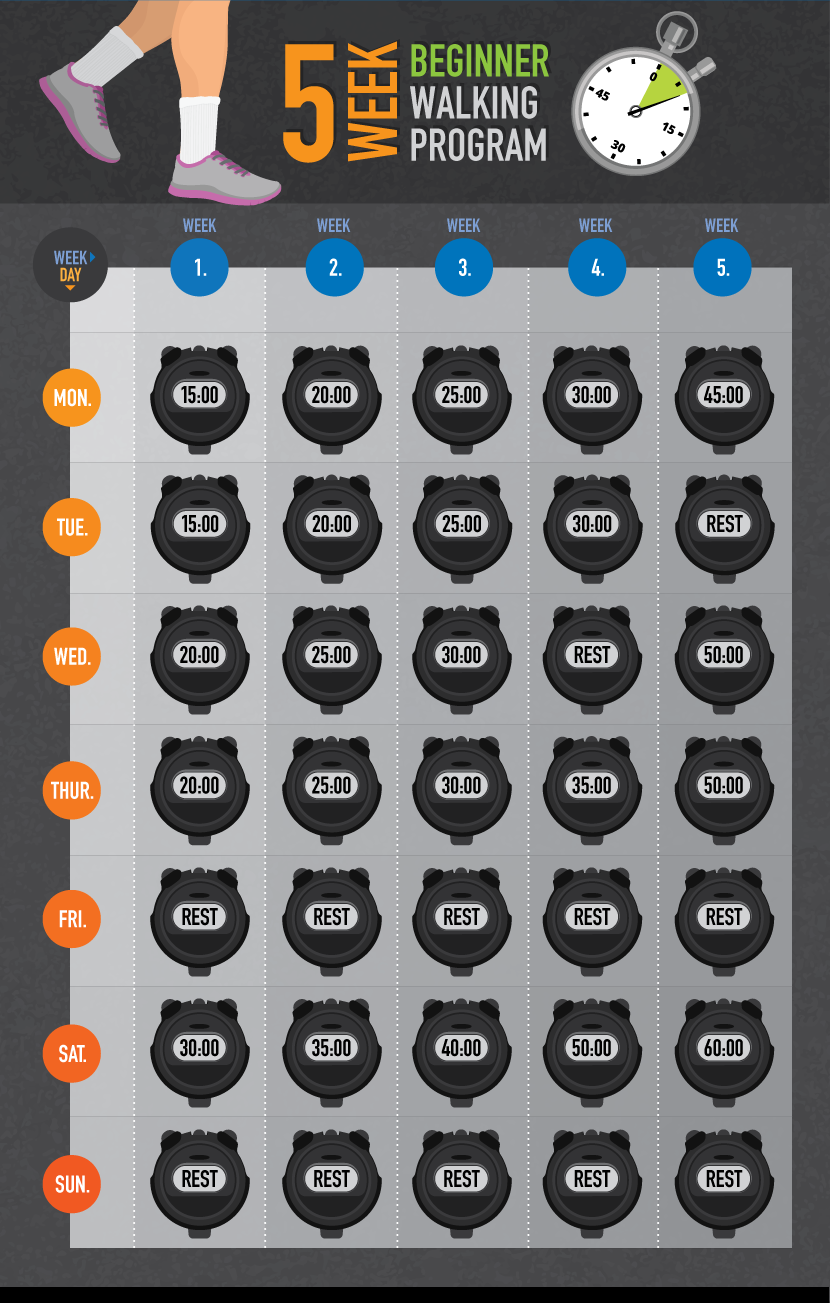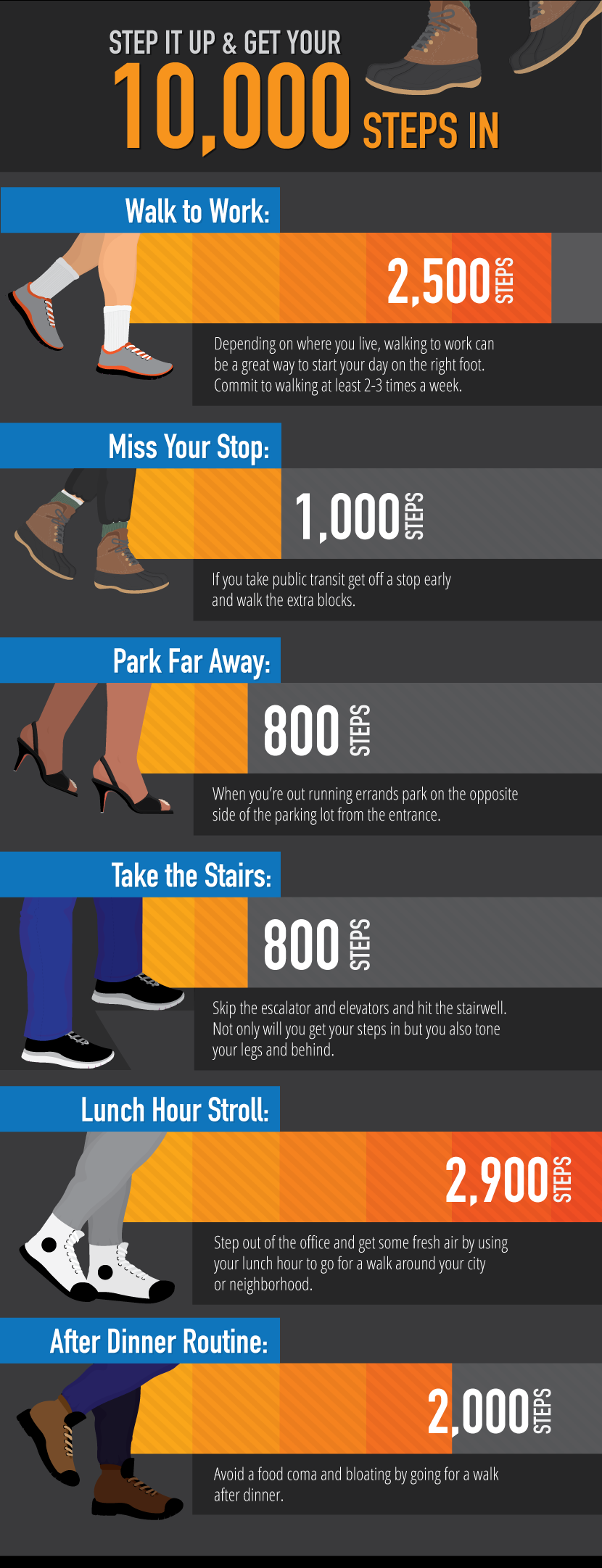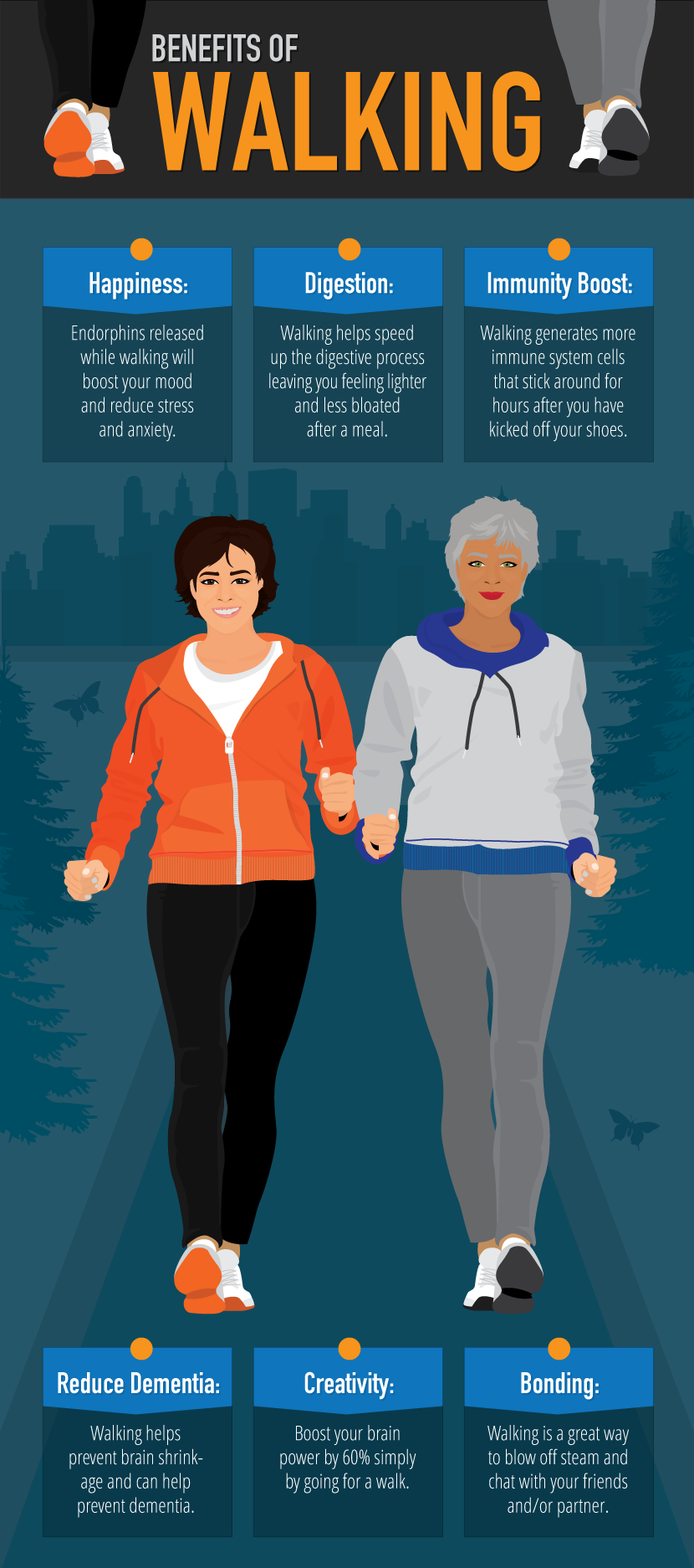Walk Your Way to Fitness
A 5-Week Walking Plan
Walking is more than a way to get from here to there. Tossing on a pair of sneakers and heading out for a stroll has numerous health benefits that go way beyond weight loss.
If you are new to exercise, recovering from an injury, or just hoping to spend more time in nature, walking is the perfect first step.
Getting Started on a Walking Program
The best part about walking for health and fitness is that all you need is a pair of sneakers.
If you have an injury, or are recovering from one, or if you struggle doing weight-bearing activities,
it is recommended that you consult your physician before incorporating any physical activity into your routine.

Once you are committed to starting a walking program, schedule 15–20 minutes 5 times a week to get outside and find your stride.
Day 1 should involve a brisk walk for 15 minutes that is slightly faster than a leisure stroll,
but not so quick that you can’t comfortably carry on a conversation.
Assess how you feel after your first day. A little soreness can be expected if you are not used to walking for longer intervals.
Repeat your 15-minute route on Day 2. If you woke up feeling great after your first walk, tack on an extra 5 minutes on the second day.
If you are feeling fatigued, Day 3 can be used as a rest day.
However, if you are still feeling energized and strong, go for another 15- to 20-minute walk.
Day 4 will be your final walk before you rest day, so really try and push yourself.
If you have been maintaining 15 minutes all week, bump it up to 20 minutes. If you have been going for 20-minute walks, aim for 25 minutes.
Day 5 is the perfect time to rest and reflect on your success so far this week.
You have already walked between 60 and 80 minutes,
which is about half the amount of moderate weekly exercise recommended by the Mayo Clinic.
Now that your legs are rested, it’s time to push yourself with a 25–35 minute walk.
You’re going to be walking farther than you have all week,
so make sure you start out slower than usual and gradually build speed over the duration of your walk.
Day 7 is your last rest day for the week. Keep this framework each week while adding time,
distance, and speed to your workouts. Before you know it, you will be walking for 60 minutes straight!
What’s in a Number?
If you have been walking for a while and are ready to kick it up a notch, strap on your step counter, and aim to be part of the 10,000 Steps a Day Club.
While 10,000 steps isn’t an official recommendation by the Center for Disease Control, it is an achievable goal to help you stay healthy and active.
By walking 10,000 steps each day, you are covering roughly 5 miles (there’s roughly 2,000 steps per mile) while burning an additional 3,500 calories a week.
That is equivalent to 1 lb of fat! Currently the average American is only walking 5,900 steps per day.http://www.businessinsider.com/heres-how-much-the-average-american-walks-every-day-2015-7
To put this into perspective, a sedentary lifestyle is defined as walking less than 5,000 steps per day.
If you are currently part of the sedentary category, don’t fret. Here are some changes you can make to help you get your steps in.

- Walk to work: If you live within walking distance of your office, this is an easy change to make.
Start by vowing to walk to work three days a week. Not only will you get more steps in, but the fresh air will leave you feeling alert and focused by the time you arrive at the office.
- Skip a stop: If you commute on a bus, metro, or train, get off a stop or two before your workplace. These extra few blocks will quickly add up on your step counter.
- Back of the lot: When heading to the shopping mall or grocery store, choose a parking space far from the entrance.
Not only will you get extra steps in, but you will also have lots of parking spaces available and no worries about carts or car doors dinging you.
- Take the stairs: Skip the elevator and head for the stairwell. Climbing stairs is a great way to tone your legs and behind, while improving your cardiovascular fitness.
If you work on the 20th floor of a high-rise, taking the stairs might seem like an impossible task – especially first thing in the morning.
Instead of dismissing the idea, hop off the elevator a few floors early and continue your commute in the stairwell. Slowly add more floors until you can conquer them all.
- Lunch hour stroll: Keep a pair of sneakers at your desk and head out of the office on your lunch break for a walk.
It’s a great time to get some fresh air, clear your head, and relax a little before a long afternoon of meetings and emails.
- After-dinner routine: Make it part of your evening routine to head outside for a stroll after dinner. It’s a great opportunity to set a healthy example and bond with your family. The dishes can wait.
Unexpected Benefits of Walking
Losing weight, toning your legs and buttocks, and having more energy are great benefits associated with walking,
but these aren’t the only benefits your body will experience when you lace up your shoes.
You might be surprised by these additional health benefits associated with walking.

- Happiness: Exercise is a great way to boost your mood. Going for a brisk walk can help reduce anxiety and stress.
- Dementia Prevention: Going for a 30–40 minute walk a few times a week can prevent brain shrinkage and memory loss.
- Digestion: Going for a walk after a meal can help speed up your rate of digestion. A quick 15-minute walk will stimulate your midsection and help you feel less bloated.
- Immunity Boost: Studies suggest that walking for 30 to 40 minutes will boost the amount of immune system cells in your body.
This increase in cells remains for several hours after exercising.https://jonbarron.org/article/walk-away-colds Also, when a person follows a regular workout routine, there appears to be a cumulative effect that helps protect the body from illness over time.
- Get Creative: It has been proven that walking can boost your creativity by approximately 60 percent.http://news.stanford.edu/2014/04/24/walking-vs-sitting-042414/ The next time you are stuck writing a paper or struggling with an email to your boss, go for a quick walk – the answer will come to you.
- Bonding Time: Did you know that going for a walk can strengthen your relationship? Whether it’s with a co-worker or partner, a simple walk will facilitate conversation,
whether it’s about your day or the odd-looking tree in the neighbor’s lawn. It is also a great way to blow off steam and vent about a tough day in the office, or the guy who cut you off.
Whether you have had a stressful day or you want to start on a weight-loss journey, walking is the perfect solution.
Start today by slipping on your tennis shoes and exploring your neighborhood. You might be surprised by how quickly you notice the benefits.
Embed the article on your site

